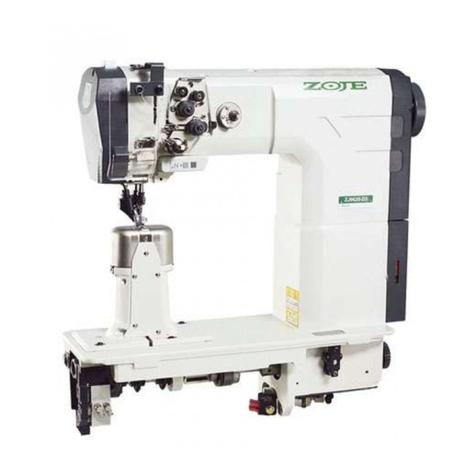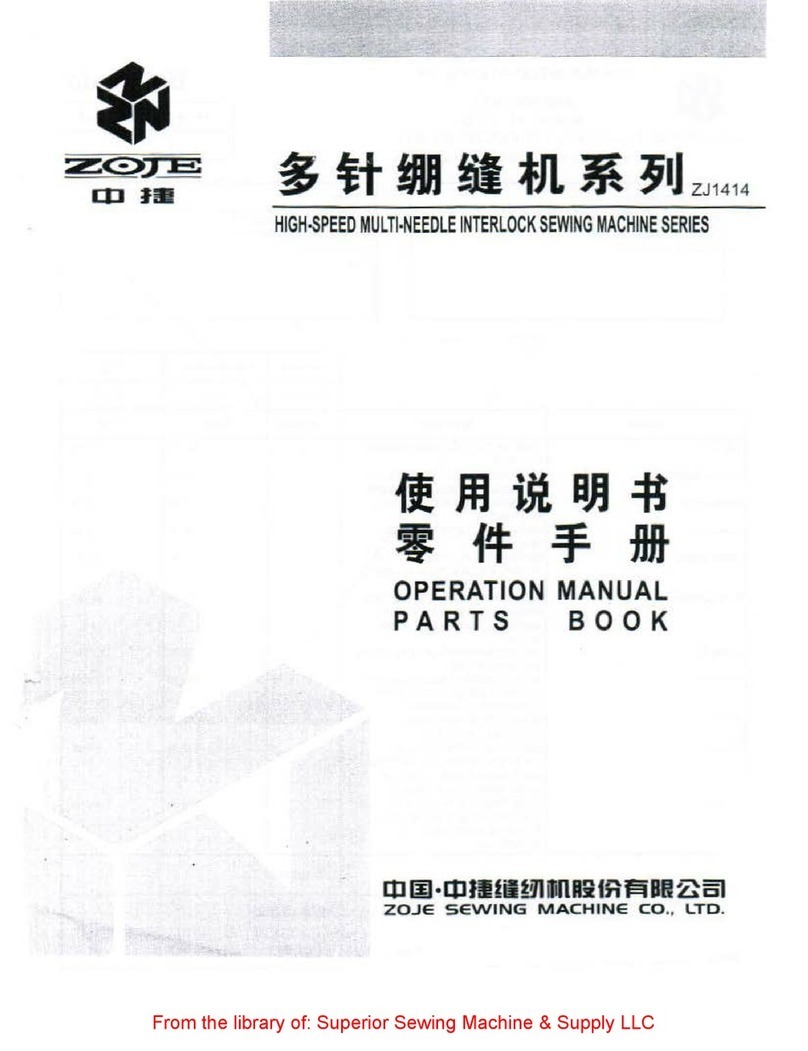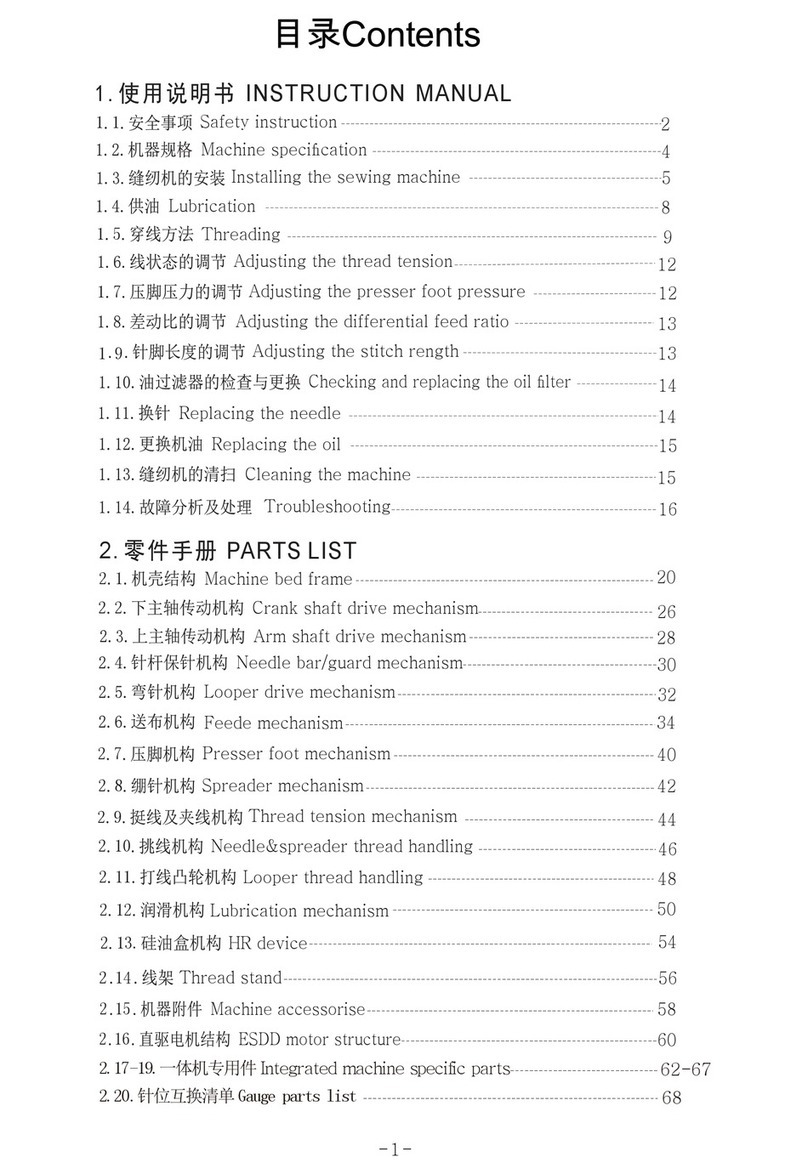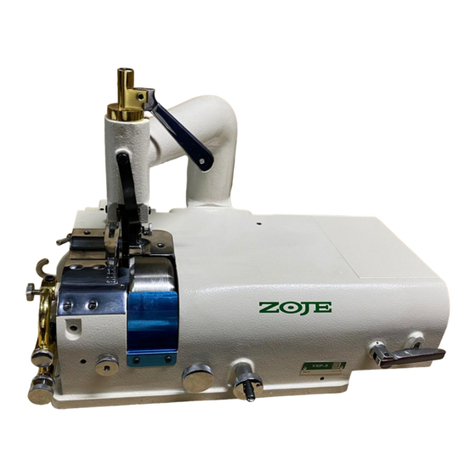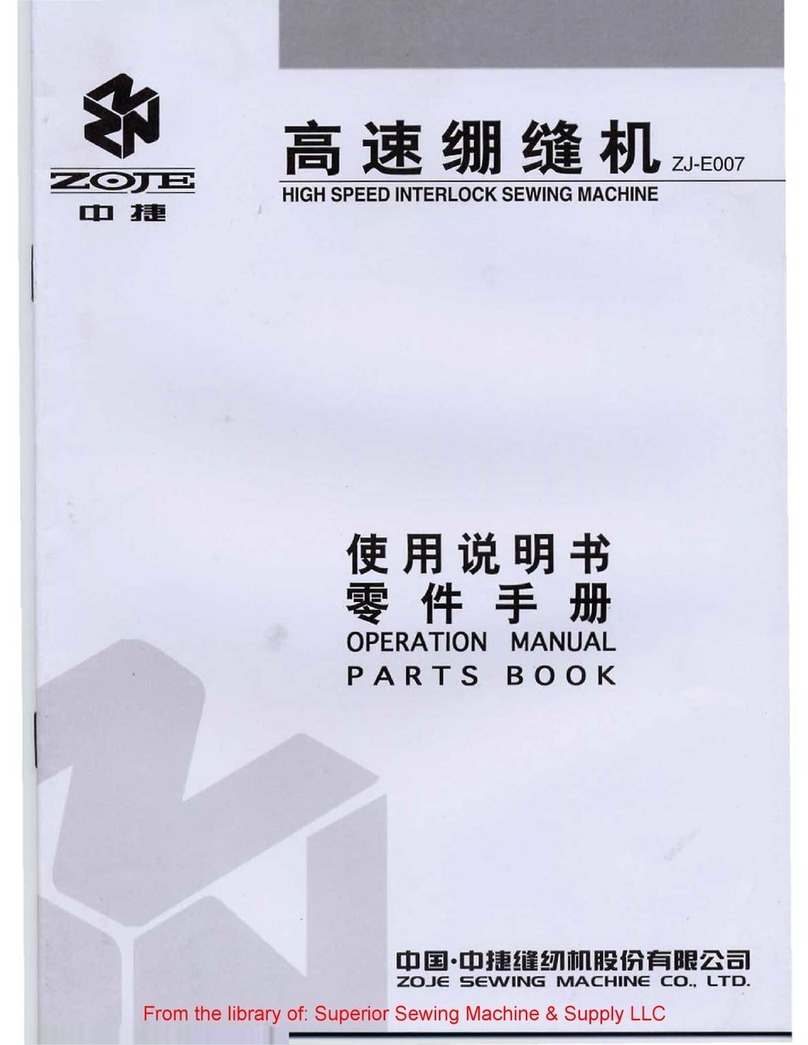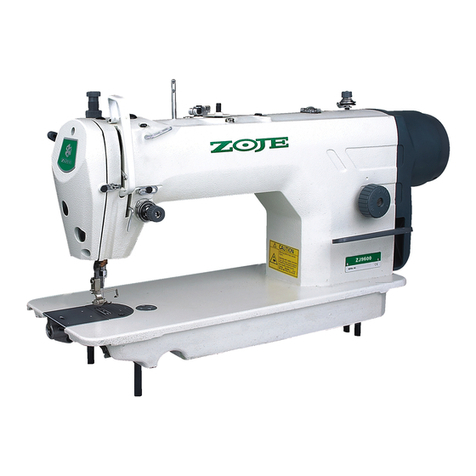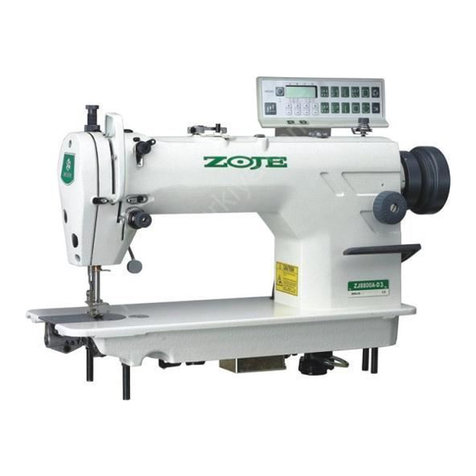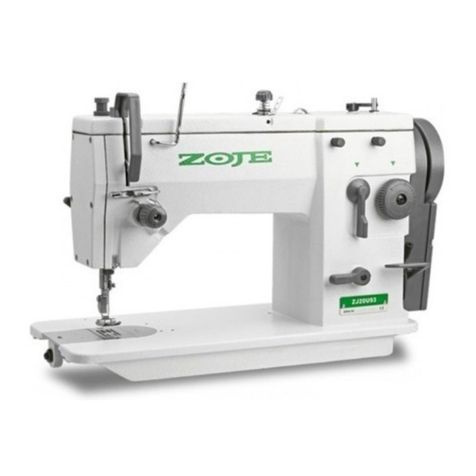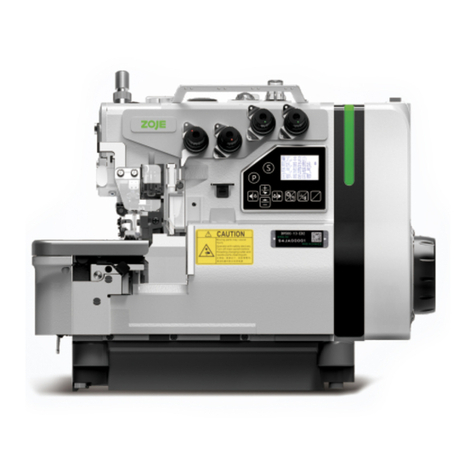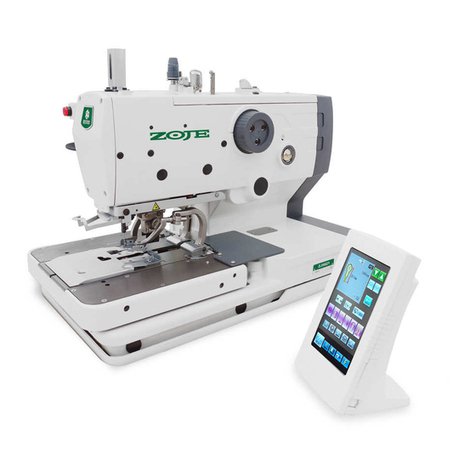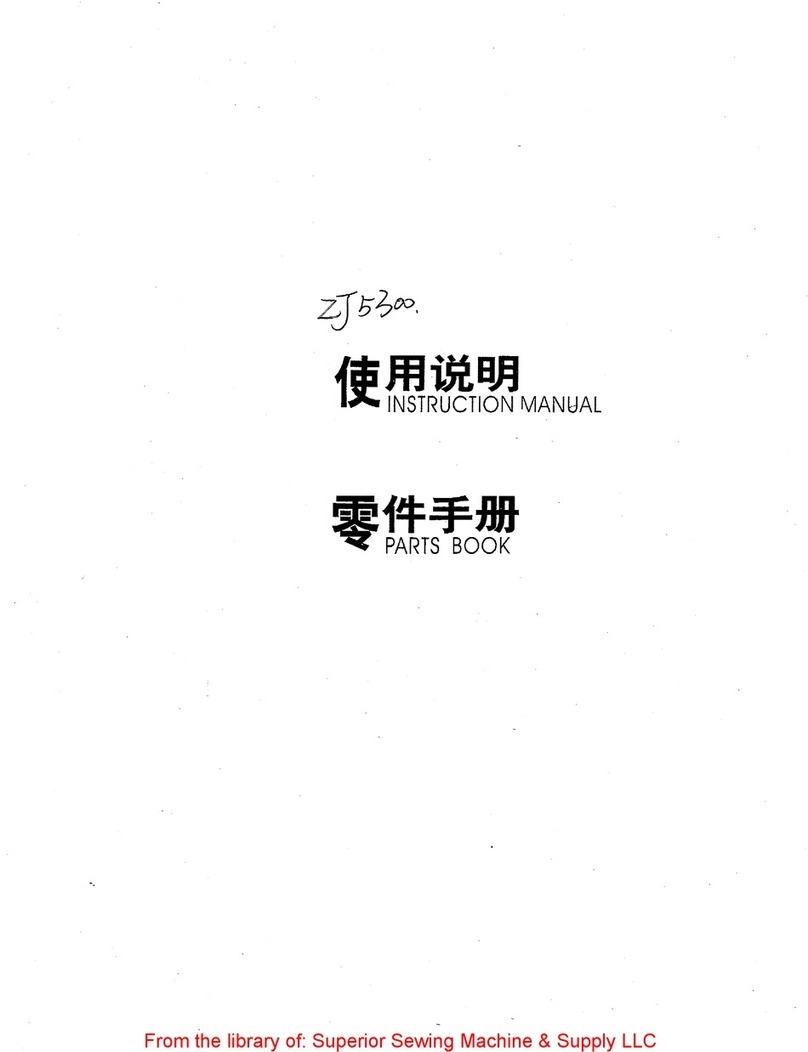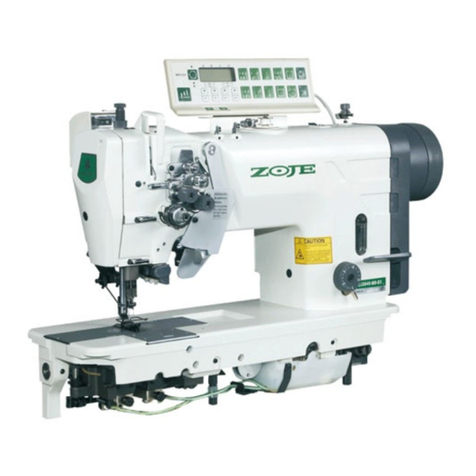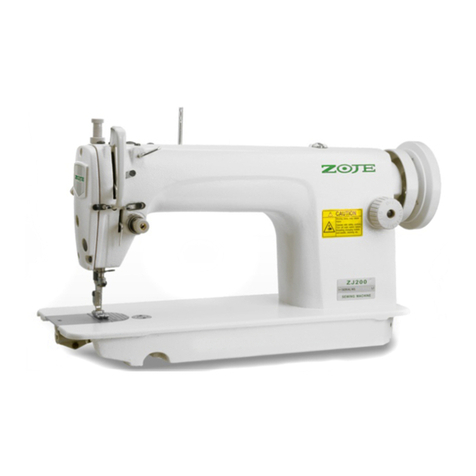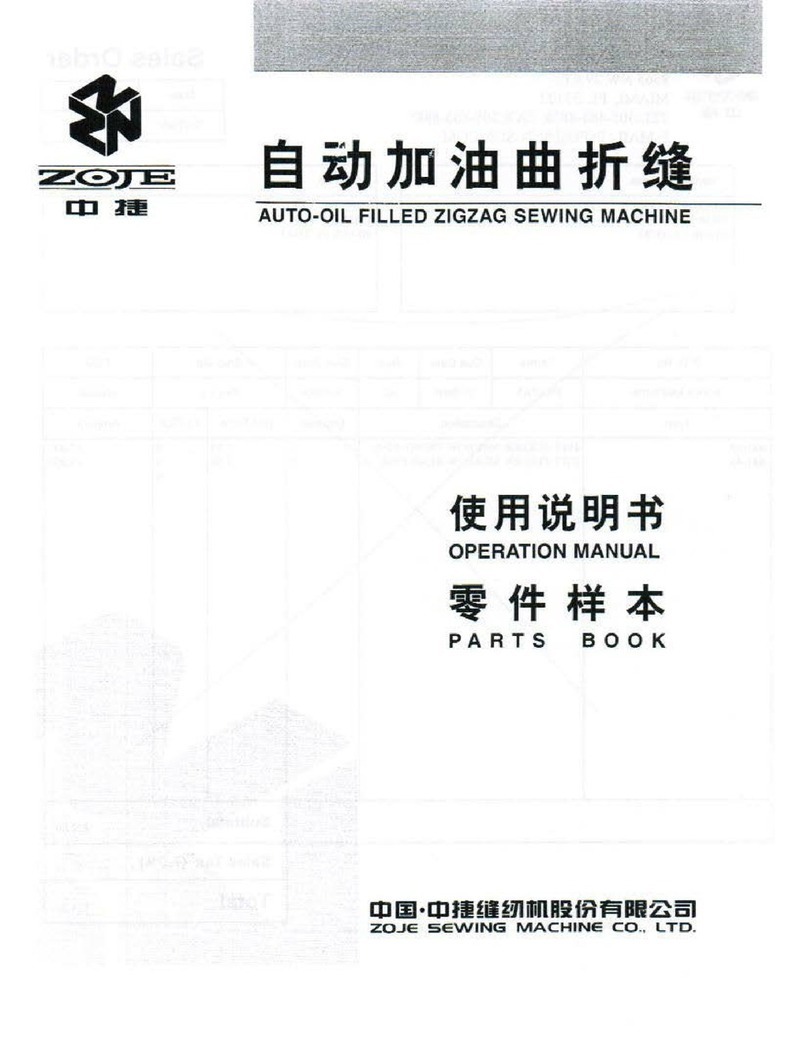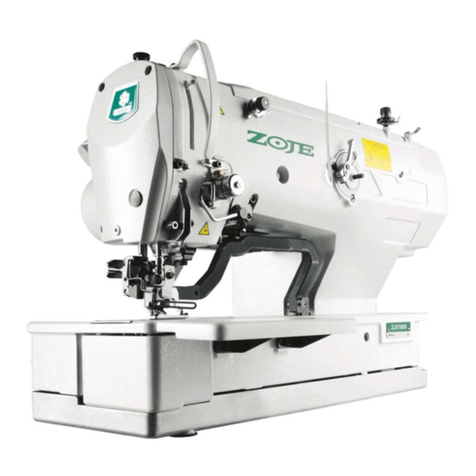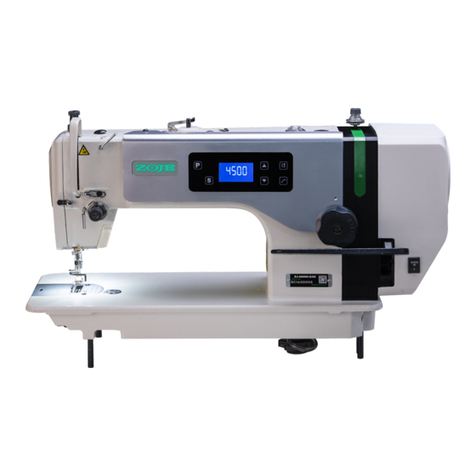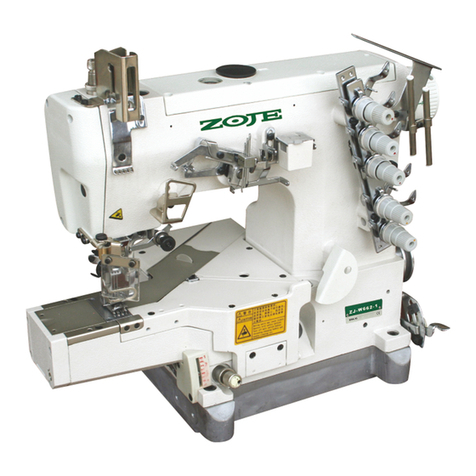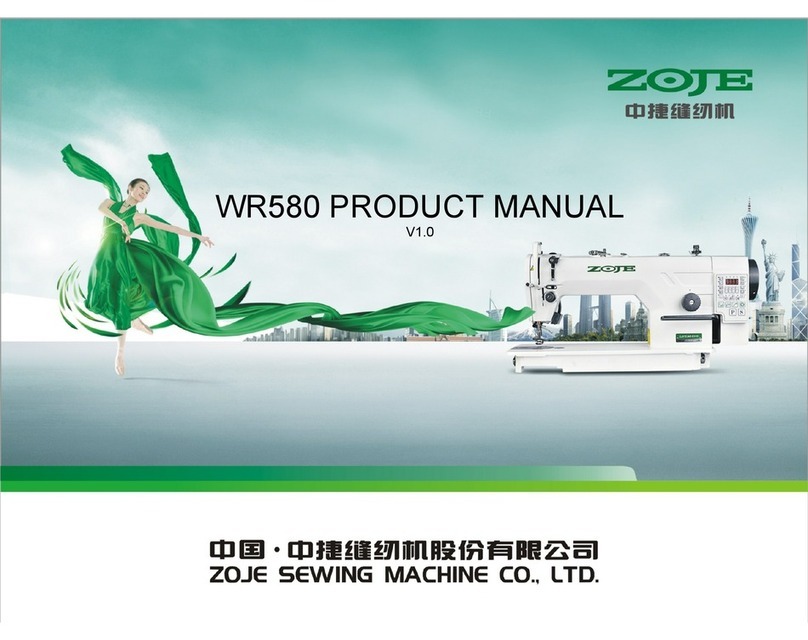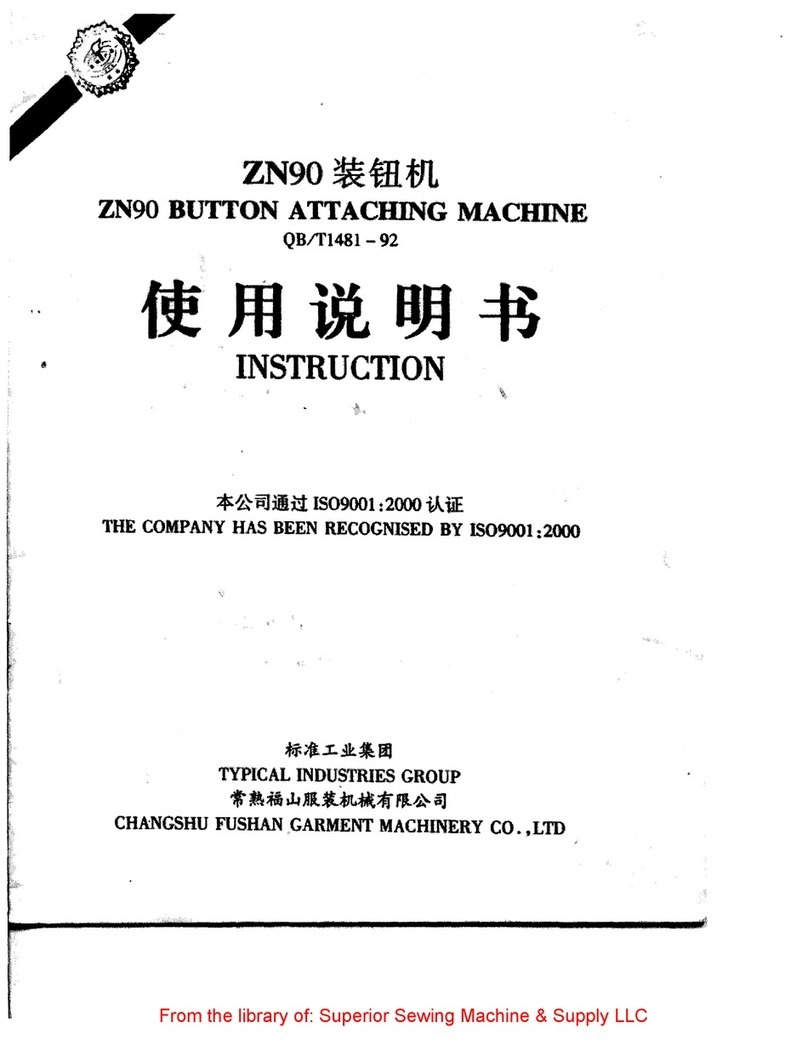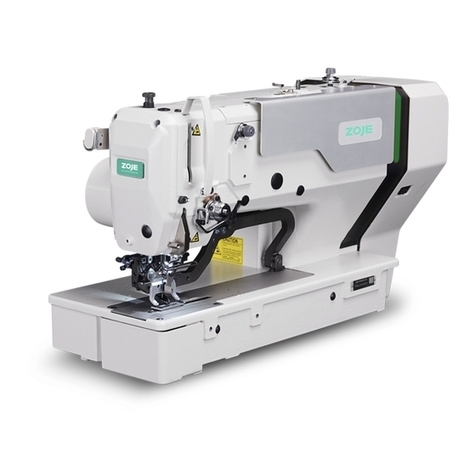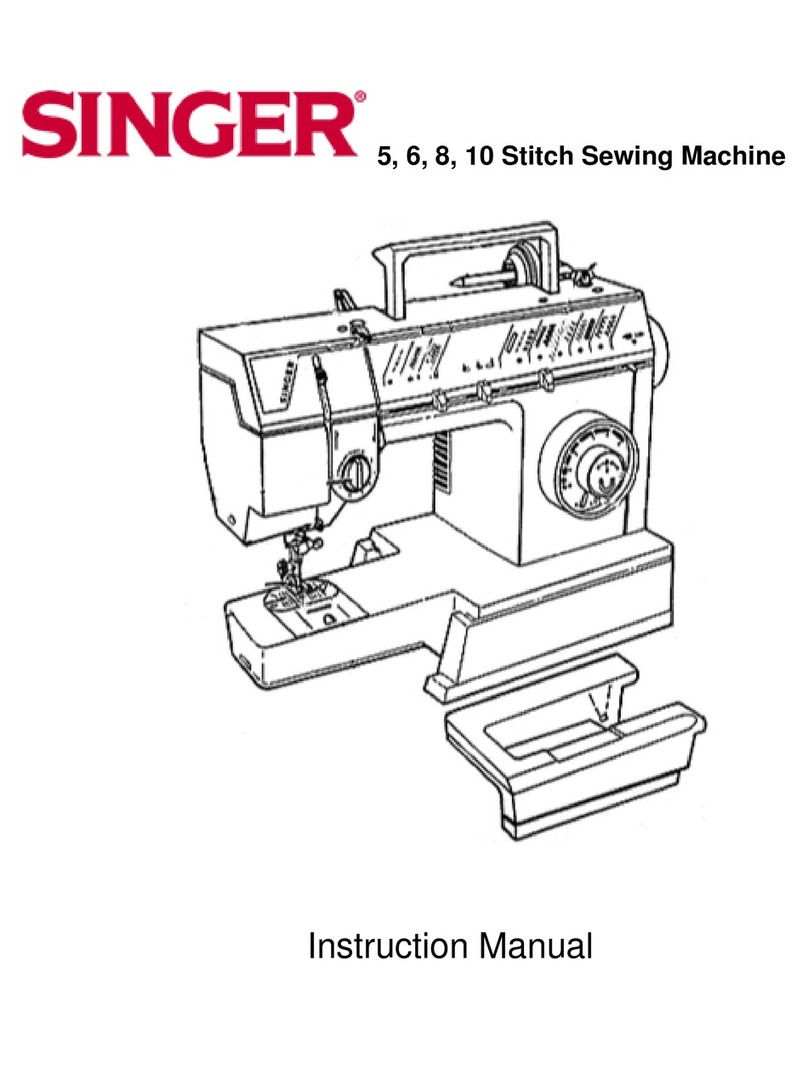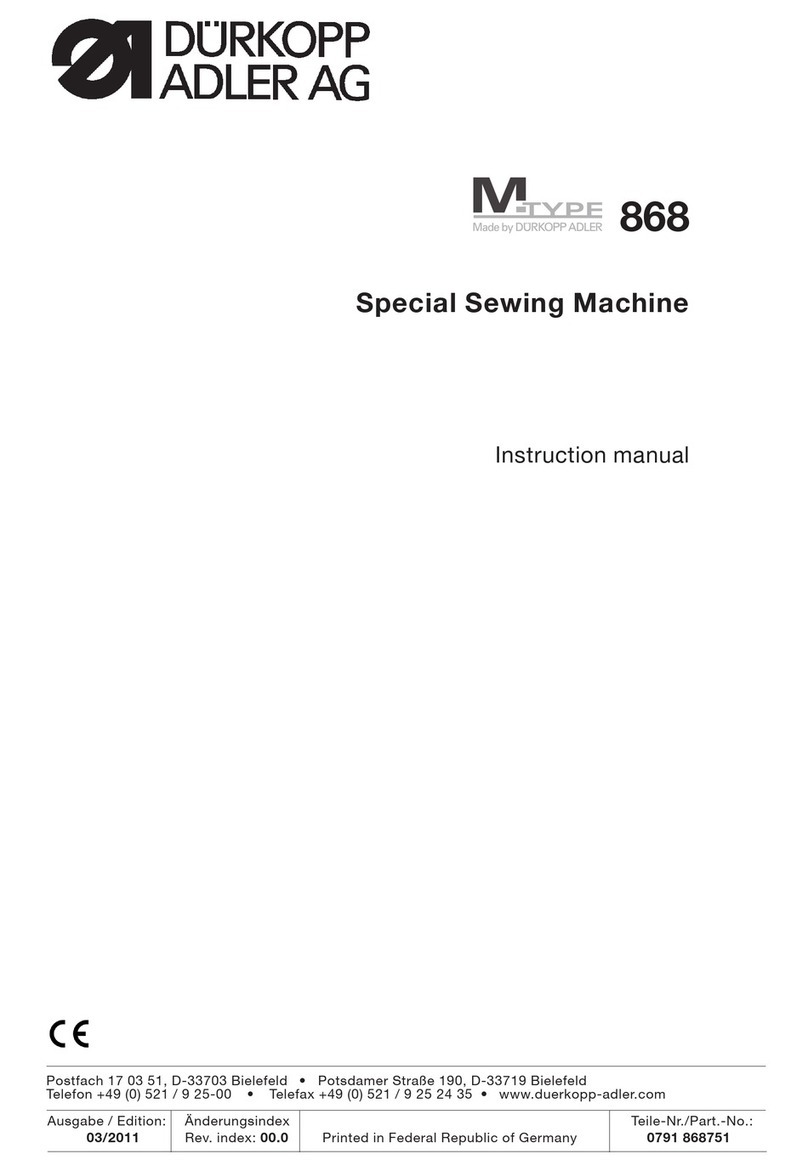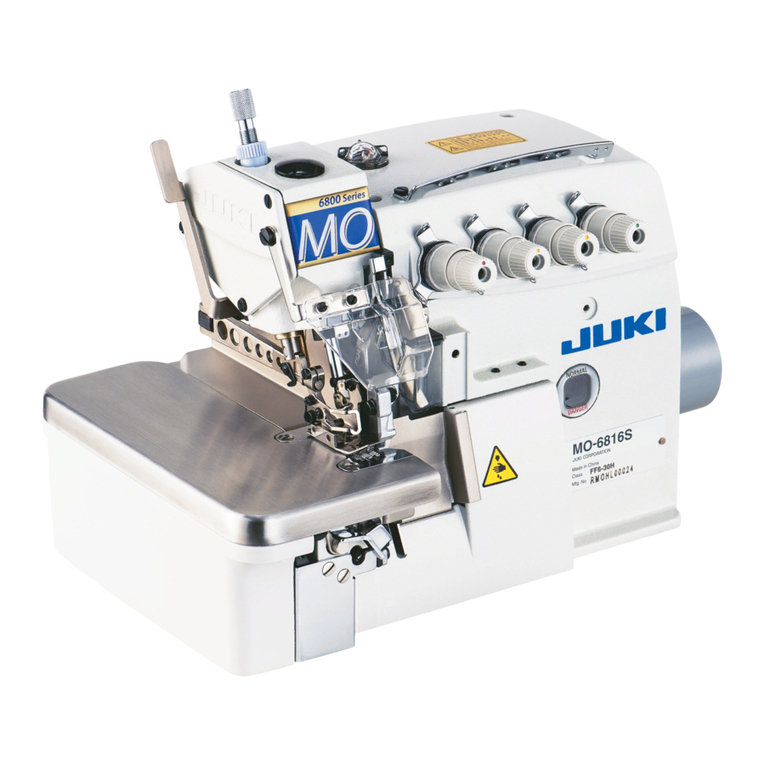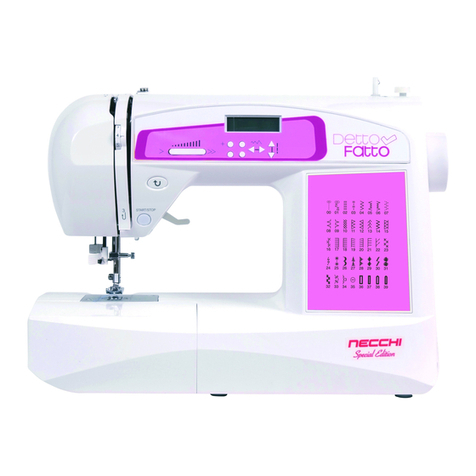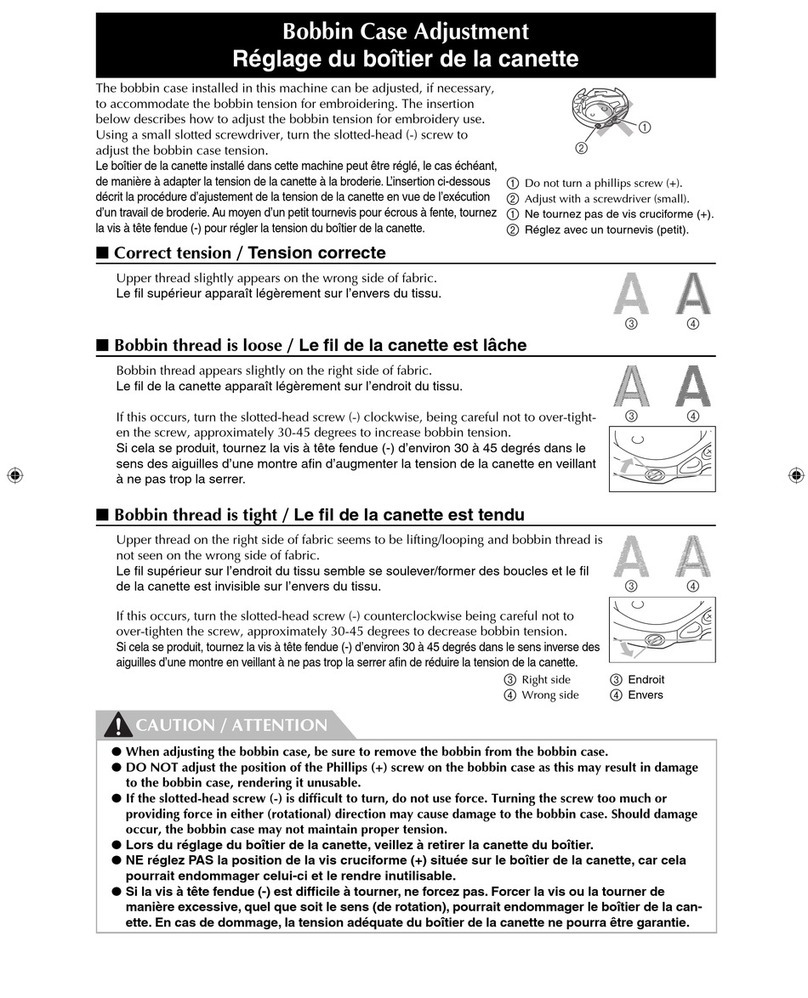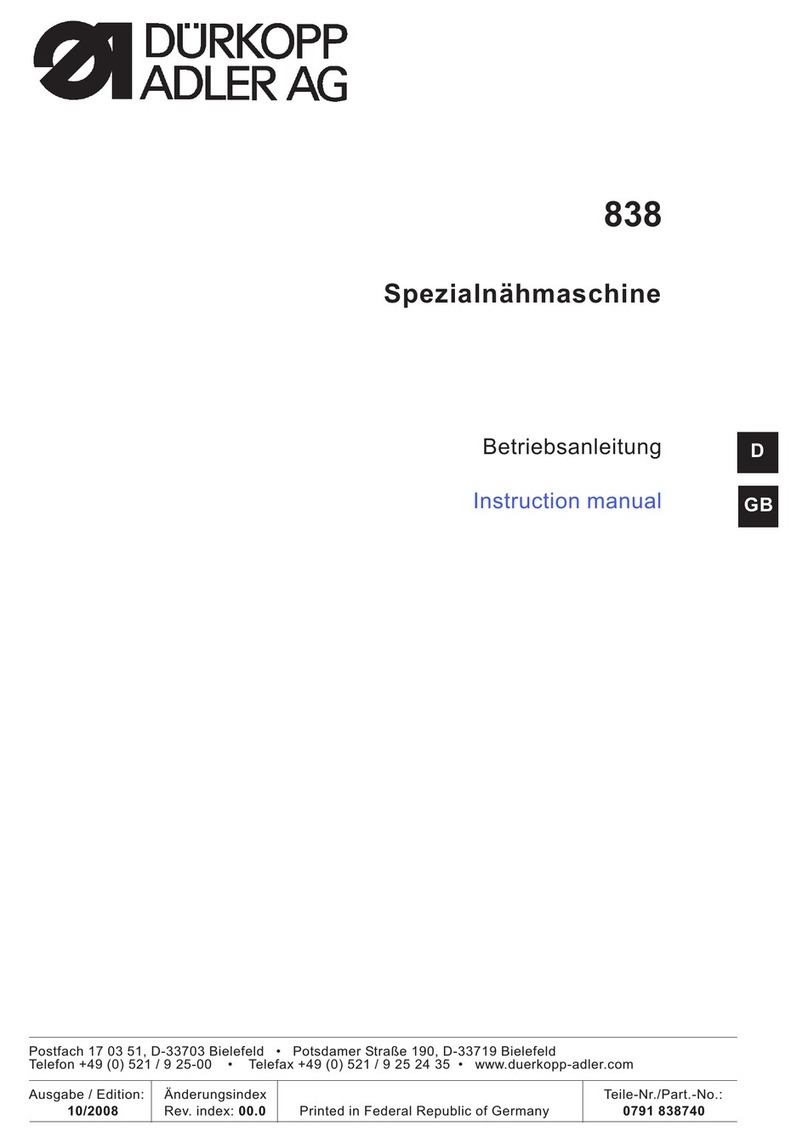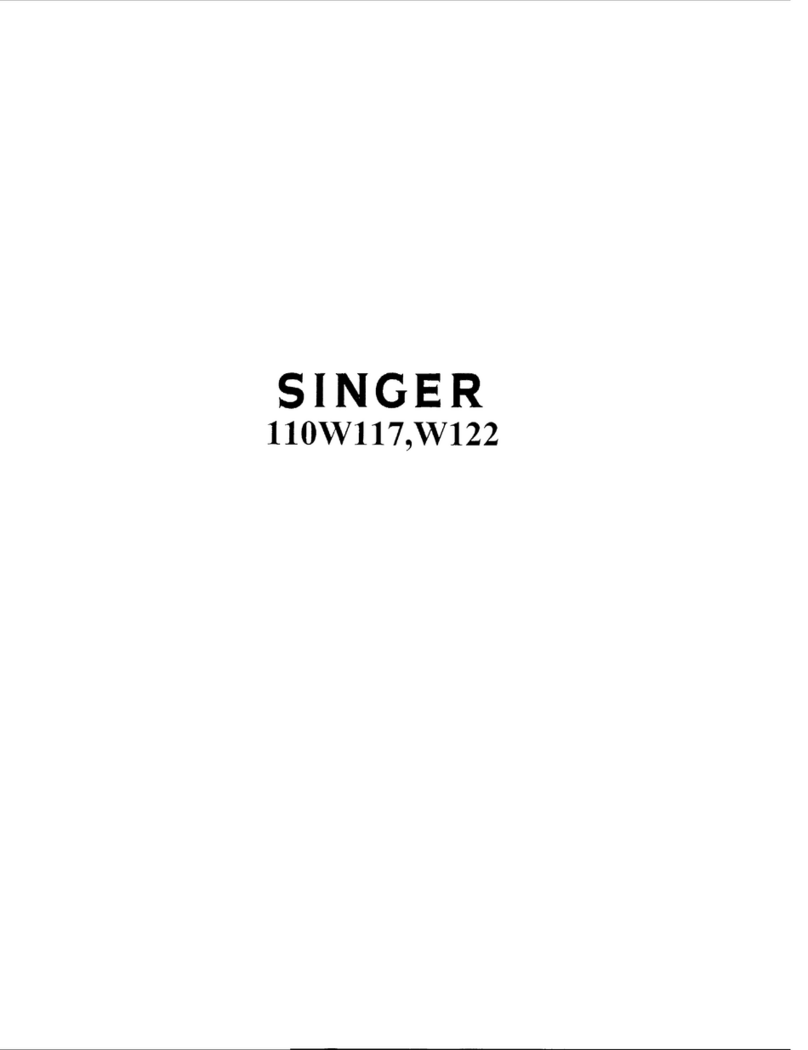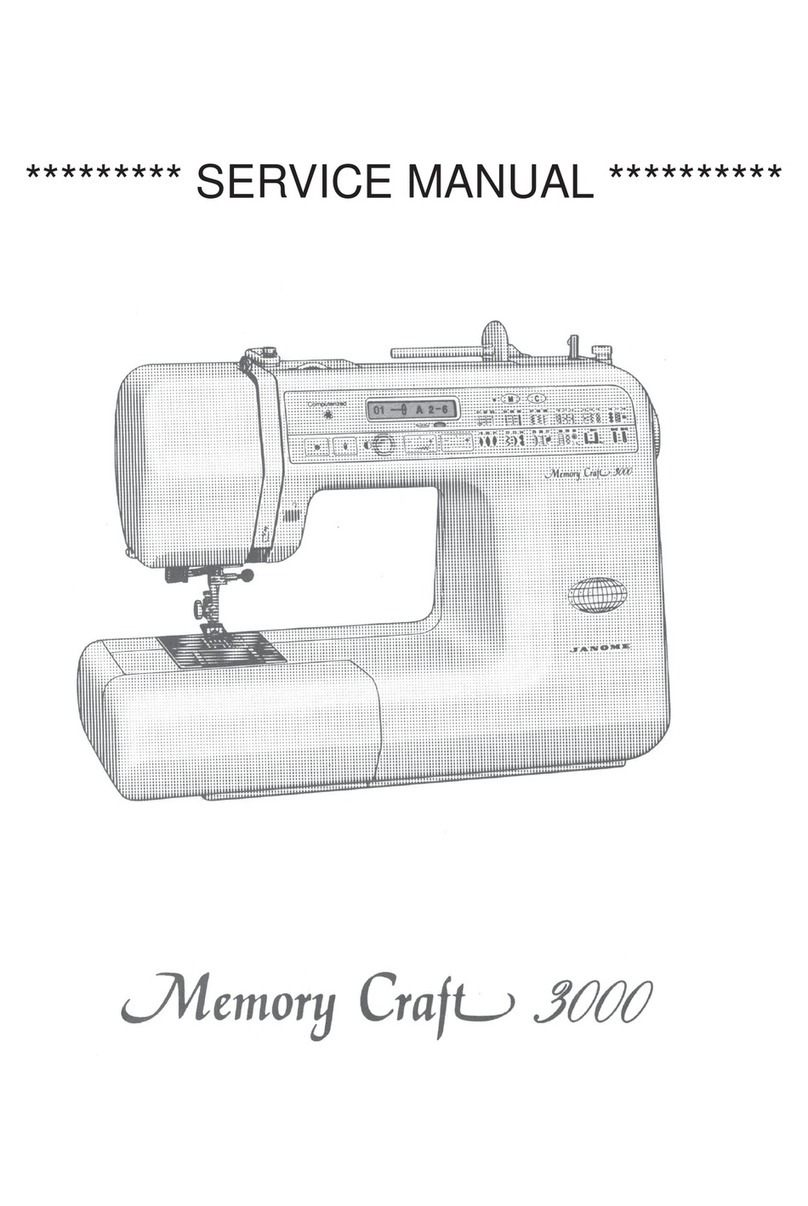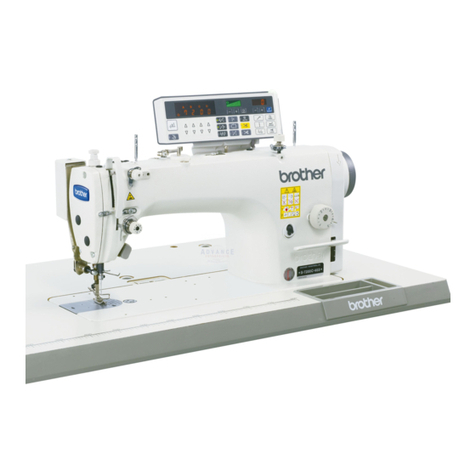ZOJE ZJ2628 User manual

ZJ2628
CYLINDER
BED
COMPOUND
FEED
LOCKSTITCH
SEWING
MACHINE
OPERATING
INSTRUCTIONS
From the library of: Superior Sewing Machine & Supply LLC

1.
MAIN SPECIFICATION
Sewing speed
Stitch length
Needle bar stroke
Presser foot lift
2000s.p.m.
0-5mm
33.2mm
7mm (Manual)
14mm(Knee)
12.
INSTALL THE MOTOR ( Fig.1 )
Align Motor Pulley Groove (B) and Balance
Wheel Groove (A) by moving the Motor(C) leftward
or
rightward.
Needle
Lubrication
Reverse feeding mechanism
DPX
17 18'-22"
Auiomatic
Have
1
13. CONNECT THE CLUTCHLEVERWITH THE PEDAL ( Fig.2 )
1.
The optimum tilt angle
of
Pedal (A) is
approximately
15
degree.
2.
Adjust Clutch Cover (D) so that Clutch Lever
(C) and Draw
Bar
(B) run the line.
3.The balance wheel should rotate counter-
clockwise when viewed from the outside
of
Balance
Wheel (G). The direction
of
the motor pulley rotation
can be reversed by reversing (tnrning over 180 degree)
the power plug
of
the motor.
4.
Adjust the tension
of
V-belt (F) by tnrning
Motor Vertical Position Screw (E). The proper tension
of
the V-belt is a slack
of
10-20mm when the belt is
depressed at the center
of
the belt byfinger.
14. PREPARATIONAND LUBRICATION ( Fig.3 )
l)
Cleaning the machine
Before leaving the factory, the machine parts are
coated with rust-preventive grease, which may
be
hardened and contaminated
by
dust during storage and
shipment. This grease must be removed with gasoline.
2) Examination
Although each machine is confirmed strictly and
test before leaving the factory, the machine parts may
be loose
or
deformed after long distance transportation
with jolt. A thorough examination must be performed
after cleaning the machine. Turn the balance wheel
to
see
if
there is running obstruction, parts collision,
uneven resistance
or
abnormal noise.
If
these exist,
adjustment must be made accordingly before run in
operation.
3) Oiling
(1)
Required amount
of
oil
Line (A) on the oil reservoir: Max. oil level
Line (B) on the oil reservoir: Min. oil level
If
oil level goes down under Line (B), oil cannot
be distributed to each part
of
the machine, thus
causing the parts a seizure.
2
Always use only
No.l8
special machine oil for
high speed sewing.
Be
sure to replenish oil to Line (A)
before starting operation.
Ci)
Replacing oil
To
replace oil, remove Screw (C) to drain oil.
After
completely draining
off
oil, clean the oil
reservoir and securely tighten Screw (C), then fill the
reservoir with fresh oil
-~.
--
__
Q:J_~---
l
--
/;.
©·-
...
From the library of: Superior Sewing Machine & Supply LLC

Is.
REPLACE NEEDLE <
Fig.4)
Turn the balance wheel to lift needle
bar
to the
upper end
of
its stroke. Loosen Needle Clamp Screw
(B) while keeping the long groove
of
the needle(C)
leftward, fnlly insert the needle shank up to the
bottom
of
the needle socket. Then tighten Needle
Clamp Screw (B).
I6.RUN IN OPERATION (Fig.5)
Run-in operation is required for a new sewing
machine,
or
a sewing machine left out
of
operation for
a considerable length
of
time.
I)
Remove Rubber Plugs (A) on the top
of
the
arm and replenish sufficient amount
of
oil, and also
to
the red oil hole (D).
· 2) Lift Presser Foot (B).
3) Run the machine at a low speed
(I
000-1500spm) to check oil distributing condition
through Oil CheckWindow (C).
4)
Perform run-in operation at
I000-\500spm
for
30
minutes. After a lapse
of
one month
of
service
during which the working speed is increased gradually
and the machine runs sufficiently well, the high speed
2000spm can
be
adopted according to the nature
of
the
work.
I
7.
THREADING ( Fig.6 )
To thread the needle thread, raise needle
bar
to
the
upper end
of
its stroke, lead the thread from spooI
and
perform threading as shown in Fig.6.
To
draw the
bobbin thread, hold the end
of
the needle thread and
tum
the balance wheel to lower the needle
bar
and
then to lift
it
to its highest position. Pull the needle
thread and the bobbin thread is drawn up. Put the ends
of
needle thread and bobbin thread frontward under
presser foot.
·--L-=-
cv~~;;::..
From the library of: Superior Sewing Machine & Supply LLC

Is.
WINDINGADJUSTMENT <Fig.
1)
I)
The wound bobbin thread should
be
neat and
tight,
if
not, adjust the winding tension
by
turning
Tension Stnd
Nut
(A)
of
bobbin winder tension
bracket.
Note: nylon or polyester thread should
be
wound
with little tension, otherwise, Bobbin (D) might break
or deform.
2) When the wound thread layer does not present
a cylindrical shape as shown in Fig.7 (a), loosen Set
Screw (B)
of
bobbin winder tension bracket and slide
Bracket (C) leftward
or
rightward.
If
thread is wound
as shown in Fig.7 (b), move the bracket rightward, but
if
thread is wound as shown in Fig.7 (c), move the
bracket leftward.
After adequately positioning the bracket, tighten
Set Screw (B).
3) Do not overfill the bobbin. The optimum
length
of
thread will fill about 80%
of
bobbin capacity.
This can be adjusted
by
adjusting Screw (E)
of
bobbin
winder stop latch.
a~
19.
SET STITCH LENGTH
AND
REVERSE FEEDING (
Fig.8)
I)
Stitch length can be set
_by
turning Dial (A).
2)
The figures on face (B)
of
dial show stitch
length in
mm.
3)
Reverse feeding starts when Reverse Feed
Lever (C) is depressed, and the machine will feed
forward again
if
Reverse Feed Lever (C) is released.
----®
From the library of: Superior Sewing Machine & Supply LLC

Ito. ADJUST THREAD TENSION (Fig.9,10,U)
Generally, the thread tension is
to
be adjusted
according to the sewing materials and sewing
conditions.
Fig.9 shows different stitch forms.
Normal
stitch
form should be as shown in Fig.9 (a).
When
abnormal stitches cause puckering and thread
break-age, the tension
of
needle thread and bobbin
thread must
be
adjusted accordingly.
In
case needle thread tension is too strong
or
bobbin thread tension is too weak, as shown
in
Fig.9
(b),
tum
the thumb nut counterclockwise to decrease
the needle thread tension, or tighten
the
tension spring
regulating screw
of
bobbin case
to
increase the bobbin
threadtension (See Fig. 10,11)
In
case needle thread tension is too weak or
bobbin thread tension is too strong, as shown in Fig.9
(c),
tum
the thumb nut clockwise
to
increase the
needle thread tension,
or
loosen !he tension spring
regulating screw
of
bobbin case
to
decrease
the
bobbin thread tension.
ju.
ADJUST THREAD TAKE-UP SPRING
(Fig.l2)
!.Adjustment
of
the thread take-up spring stroke
Loosen the stopper screw (B) and move the
regulating ring (C) leftwards to decrease the stroke
of
!he thread take-up spring, or move the regulating ring
(C) rightwards to increase the stroke. Mter. the
adjustment, tighten the screw (B).
2.Adjustment
of
the thread take-up spring tension
Loosen the nut
(D)
and screw (E) and
tum
the
regulating screw (F) clockwise to decrease the tension
of
the thread take-up spring,
or
tum
the
regulating
screw (F) counterclockwise to increase the tension.
Thentighten the nut (D) and the screw (E).
9
a
b
c
u
From the library of: Superior Sewing Machine & Supply LLC

j12.TIME NEEDLE MOTION TO HOOK MOTION (Fig.13,14)
I.
Adjusting the height
of
the needle bar (Fig. 13)
When the needle
bar
is
at its highest point,
normally the measurement between the surface
of
the
needle plate and the upper end
of
the needle eye is
20mm.
2.
Time needle motion to hook motion
Before adjustment, set stitch length_ to minimum,
then turn the balance wheel toward you until the
needle
bar
reaches its lowest point. Continue turning
and allow the needle bar to raise about 2mrn while on
its upward stroke. With needle
bar
in this position, the
hook point (A) should be
at
the center
of
the
needle(B), and normally the measurement between the
hook point and the upper end
of
the needle eye (C)
should be 2-2.4mrn, further the clearance between
the
hook point and the needle hollow should be about
0.05 to O.lmm.
1) Lift needle
bar
to the highest position
of
its
stroke.
2) Remove the throat plate
and
feed dog, take down
needle and bobbin case
3) Loosen Screw (C)
of
hook positioner and take
down Hook Positioner (A).
4) Loosen Screw (D)
of
rotating hook, then take
down the rotating hook
5) Installing the hook can be done in reverse
sequence. Note that Needle (B) and the convex
surface
of
Hook Positioner (A) should align with a
clearance
of
0.5-0.7mm between them.
0.05 -0.Inun
Q.5-
Q.}mm
[1---'
-©
5
From the library of: Superior Sewing Machine & Supply LLC

lt4.ADJUST PRESSER FOOT (Fig.l6,17)
1.
Lift adjustment
of
presser foot (Fig.l6)
The normal height
of
the presser foot (A) should
be
8mm,
yet
it
can
be adjusted,
if
necessary, according
to
actual requirement Loosen the pressure regulating
screw(C) and lift the presser
bar
lifter to raise the
presser foot, loosen the screw (D) and move presser
bar
upwards and downwards to change the lift
of
the
presser foot.
NOTE: The changeable lift
of
the presser foot (A)
will result in the alternate movement height
of
the
presser foot (A) and the walking foot (B), therefore,
adjustment must
be
made to
it
accordingly. See
procedure 3 stated below for proper way.
2.
Pressure adjustment
of
the presser foot (A)(Fig.l6)
Turn pressure regulating screw (C) clockwise
to
increase the pressure
of
the presser foot (A), and
counterclockwise to decrease it
if
you
desire.
3. Adjustment
of
the alternate vibrating height
of
the
presser foot (A) and the walking foot
(B)
(Fig.l6)
The presser foot (A) and the walking foot
(B)
vibrate alternately with equal height when machine is
in operation,
but
it can
be
adjusted according to actual
requirements. To increase vibrating height
of
the
walking foot
(B)
and decrease vibrating height
of
the
presser foot (A), adjust as follows: Down the presser
bar lifter and tum balance wheel until the presser foot
(A) is slightly separate from
the
needle plate, loosen
screw (E) and depress the presser foot (A) to reach
needle plate and then tighten the screw (E). To
decrease vibrating height
of
the walking foot
(B)
and
increase vibrating height
of
the presser foot (A): Turn
balance wheel until the walking foot
(B)
is slightly
separate from the needle plate, loosen screw (E) and
depress the walking foot
(B)
to
reach needle plate and
then tighten
the
screw (E).
4.
Movement height adjustment
of
presser foot and
walking foot
(Figl7)
The thickness
of
the material sewn should control
the height
of
the lift
of
the presser foot and walking
foot. The lift should be
just
enough for clearance
of
the material.
To
adjuSt, loosen the net
(H)
move the
crank rod upwards to increase the up and down
movement, and downwards to decrease it,
then
tighten
nut (H).
5.
Time walking foot (B) to needle
(Figl6)
This is
the
normal timing when tum the balance
wheel toward you, after lowering the presser
bar
lifter,
the walking foot (B) should
reach
the feeder earlier
than the needle eye comes to,
and
when the needle
raises, the walking foot (B) should leave the feeder
after the needle
eye
has left the feeder. This is due
the
reason that the walking foot (B) must tightly hold the
goods while the needle is passing the goods for
avoiding irregular stitches. To adjust this, loosen
the
two screws (G)
and
adjust the rotating position
of
the
cam
(F) faster
or
slower as may be desired, and
tighten the screws (G).
From the library of: Superior Sewing Machine & Supply LLC

I
I
I15.ADJUST FEED DOG(Fig.18,19,20,21)
!.Adjustment
of
the position
of
feed dog (Fig.l8,19)
Generally, the position
of
the feed dog should he:
When minimizing the stitch length, the center
of
the
needle hole on the Feed Dog (A) should align the
center
of
the Needle Plate (B).
lf
necessary, adjust as
follow:
l)
Minimize stitch length
2)
Loosen the Screw (D)
of
the Feed Rock
Shaft Crank (Right) and move the two-Screw
(E)of
Crank.
3)
Turn Feed Rock Shaft(C) and align the
center
of
the Needle Hole on the feed dog and the
center
of
the Needle Plate (B).
4)
After the adjustment, be sure to tighten the
screw (D),(E).
2.
Relative position adjustment between needle
and
the needle hole in the feed dog. (Fig.20)
Make sure that needle
can
be
descended to the
center
of
the needle hole,
if
not, adjust it as follows:
l ) Remove the arm side cover and loosen the ·
screw (A).
2) Holding the needle
bar
and move
it
to
the
center
of
the needle hole in the feed dog, the tighten
screw (A) and replace the arm side cover
3.
Time feed motion to needle motion (Fig.2l)
The standard timing
of
feed motion to needle
motion is that the feed dog starts moving forward
when the needlepoint reaches the needle plate surface.
lf
feed motion is not timed to needle motion, adjust
as follows:
l)
Remove the arm side cover and loosen the screw
(A), (D)
of
the feed and feed lifting eccentric.
2) Holding feed and feed lifting eccentric (B) and
turn balance wheel slowly until
the
reference hole(C)
on the feed and feed lifting eccentric aligns with mark
(F).
When adjusting, the clearance between feed lltld
feed lifting eccentric (B) and eccentric sleeve (E)
should be 0.3-0.5mm.
After the adjustment, be sure to tighten the screw
(A),
(D).
7
21
From the library of: Superior Sewing Machine & Supply LLC

lt6.
REGULAR CLEANING (Fig.22,23)
1.
Cleaning feed dog
Remove the throat plate
and
clear
off
the
dust
and
lint between the feed and teeth slots.
2.Cleaning rotating hook
Swing out
the
machine
head
arid clean the
hook
Wipe the bobbin
case
with
soft cloth.
:I
From the library of: Superior Sewing Machine & Supply LLC

PARTS
LIST
From the library of: Superior Sewing Machine & Supply LLC

1.
ARM
BED
AND
ITS
ACCESSORIES
From the library of: Superior Sewing Machine & Supply LLC

1. ARM BEDAND ITSACCESSORIES
No. Ref. No. Description Pes Remarks
I.
05-0l-OOIA2 Ann I
2. 09-01-00IB2 Ann bed 1
3.
09-01-002 Trade mark plate I
4. GB827-86 Trade mark plate rivot 2
5.
05-01-003
Faceplate
1
6.
05-01-004 Set screw 1
7.
05-01-005 Knock pin I
8.
05-01-006 Thread guide (Up) I
' 9.
22TI-003C5
Thread guide (Middle) I
10. 05-0J-013 Thread guide (Lower) 1
II.
22TI-003C6
Set
screw
3
12. 05-01-014 Ann side cover 1
13. 05-01-015 Gasket for arm side cover I
14.
72TI-017
Set screw 8
15. 12H1-007C1 Oil check window 1
16.
12HI-007C2
0-ring
1
17.
22Tl-009El
Screw type tension stud I
18.
22TI-009E2
Spring for pretension I
19.
22Tl-009E3
Discfor pretension 2
20.
22Tl-009E4
Space for pretension 1
21. GB896 Stop ring I
22.
22Tl-009E5
Pretension tluead guide 1
23.
22Tl-010
Three-hole tluead guide 1
24.
22Tl-Oll
Set screw 1
25. 05-0I-007C1 Thread tension bracket 1
26.
05-0l-007C2
Thread tension stud 1
27. 05-01-007C3 Tension regulating
nut
1
28.
73Tl-002C1
Thread tension spring 1
29. 05-01-007C4 Thread tension releasiiig disc 1
30.
05-01-007C5.
Thread tension disc 2
31. 05-01-007C6 Stop disc 1
32. 05-01-007C7 Pin -1
33. 05-01-007C8-1 Thread controller disc 1
34. 05-01-007C8-2 Thread controller plate 1
35. 05-01-007C9 Screw 1
36. 05-01-007C10 Thread tension release plate 1
37.
05-01-007Cil
Screw 2
38. 05-01-007C12 Thread tension release pin 1
39.
72Tl-013
Screw 1
40. 05-01-008 Thread controller stud 1
41. 05-01-009 Thread take-up spring 1
42. 05-01-010 Tension thumb nut 1
43. 05-01-011 Thread take-up spring stup 1
44. 05-01-016 Screw I
45.
22Tl-Oil
Screw 1
46. 01-01-006 Bed side cover I
47. 01-01-007 Gasket for bed side cover 1
48.
72Tl-017
Set screw 6
49. 09-01-003 Cap for bedface plate I
50.
72Tl-004C4
Rubber plug 8
51.
72Tl-009
Rubber ping I
52.
72Tl-Oil
Rubber ping I
53. 09-01-004 Bed cover I
54. 09-01-005 Gasket for bed cover 1
55. 09-01-006 Bed
rear
cover 1
56.
09-0l-007
Gasket for bed
rear
cover 1
57.
72Tl-017
Set screw 4
58.
72Tl-017
Set screw 4
59.
22Tl-Oil
Screw l
From the library of: Superior Sewing Machine & Supply LLC

2.
NEEDLE
BAR
AND TAKE-UP
MECHANISM
··v
From the library of: Superior Sewing Machine & Supply LLC

2. NEEDLE BARAND TAKE-UP MECHANISM
No. Ref. No. Description
Pcsl
Remarks
1.
05-02-001 Thread take-up lever 1
2.
05-02-002 Hinge pin l
3. 22T2-002 Set screw 1
4. 05-02-003 Thread take-up lever driving stud l
5. 05-02-004 Oil guard 1
6.
22T8-0llC4
Set screw l
7.
05-02-005Al
Needle
bar
crank 1
8.
22T2-006 Set screw 1
9. 22T2-007 Set screw 1
10. 05-02-006 Hinge
pin
2
11.
72T2-004B2 Set screw 1
12. 05-02-007 Needle
bar
link 1
13. 05-02-008 Needle
bar
adaptor I
14.
22T7-0I5
Set screw 1
15.
05-02-009Bl
Needle
bar
rock frame rock shaft I
16. 05-02-009B2 Crank (Left) 1
17.
GBI17
Pin for crank l
18. 05-o2-009B3 Slide block for needle
bar
rock frame 1
19. 05-02-009B4 Position bracket I
20. 72T2-003
Screw
1
21. 05-02-010 Needle
bar
rock frame I
22.
05-02-0ll
Hinge
pin
1
23. 22T2-002 Screw I
24. 05-02-012 Needle
bar
1
25. 04-02-004 Thread guide for needle
bar
1
26. 04-02-005 Screw 1
27. Needle 1
28. 22T2-017 Needle clamp screw - I
29.
05-02-014Cl
Crank (Right) I
30. 02-08-007 Screw 1
31. 09-02-00IC2 Crank level-link 1
32. 22T5-001A4
Screw
(Right) 1
33. 05-05-003 Hinge pin (Upper) 1
34. 05-02-015 Bushing for rock shaft (Left) 1
35. 05-02-016 Bushing for rock shaft (Right) 2
36. 22T2-002 Screw I
37.
22Tl-Oll
Screw
From the library of: Superior Sewing Machine & Supply LLC

3.
ARM
SHAFT
AND
VERTICAL
SHAFT
MECHANISM
~~
@
From the library of: Superior Sewing Machine & Supply LLC

3.ARM SHAFTAND VERTICAL SHAFT MECHANISM
No. Ref. No. Description
Pcsl
Remarks
1.
05-03-00lAl
Ann shaft 2
2. 22T3-001A2 Rubber plug 1
3.
22T6-005Bl
Collar for arm shaft 2
4. 22T3-002B2 Set screw 1
5.
22T3-003 Ann shaft bushing (Left) 1
6.
05-03-007 Ann shaft bushing (Middle) 1
7.
22T7-002
Set
screw
1 .
8.
05-03-006 Ann shaft bushing (Right) 1
9.
22T3-006F Oil seal 1
10. 02-03-001 Balance wheel 2
11.
22T3-007C2 Set screw 1
12. 22T3-008 Set screw 1
13. 09-03-00I B1 Feed lifting eccentric 2
14. 22T2-002 Set screw 1
15. 09-03-001
B3
Baflle plate 3
16.
04-01-017
Set
screw
1
17.
09-03-001B2 Feed linklever 1
18.
22Tl-Oll
Screw 1
19. 05-03-003 Vertical shaft 1
20. 22T3-010E2a1-2 Bevel gearfor arm shaft 1
21.
22T3-0l
OE2a2-2 Bevel
gear
for vertical shaft (Upper) 8
22. 22T2-005B3 Set screw 1
23. 22T3-010E2b1-2 Bevel
gear
for hook shaft 1
24. 22T3-01OE2b2-2 Bevel
gear
for vertical shaft (Lower) 1
25. 05-03-004 Vertical shaft bushing (Upper) 1
26. 05-03-005 Vertical shaft bushing (Lower) 2
27. 22T2-002 Set screw -
-
15
From the library of: Superior Sewing Machine & Supply LLC

4.
HOOK
SHAFT
MECHANISM
From the library of: Superior Sewing Machine & Supply LLC

4. HOOK SHAFT MECHANISM
No. Ref. No. Description Pes Remarks
l.
09-04-001 Rotating hook shaft 1
2. 09-04-007 Bearing block 1
3.
09-04-008 Set screw 4
4.
22T4-001Alal
Filter screw 1
5.
22T4-001Ala2
Filter 1
6.
05-04-003 Rotating hook complete 1
7.
Bobbin case 1
8.
22T4-017 Bobbin 1
9. 09-04-004 Collar for hook shaft (Left) 1
10. 09-04-002Al Collarfor hook shaft (Right) 1
11.
09-04-009 Hook shaft bushing (Right) I
12.
22Tl-Oll
Set screw 2
13. 09-04-006 Hook shaftbushing (Left) 1
14.
22T6-001Alb
Set screw 2
15.
09-04-003 Rotating hookpositioner 1
16. 09-04-005 Set screw 2
I
ji
II
-
-
17
From the library of: Superior Sewing Machine & Supply LLC

5.
STITCH
LENGTH
REGULATING
MECHANISM
t.---
----
...;----
'
....
....
If\
_:::..
\Y
---
---
18
From the library of: Superior Sewing Machine & Supply LLC

5.STITCH LENGTH REGULATING MECHANISM
No. Ref. No. Description Pes Remarks
I.
09-05-003 Reverse feed link lever I
2.
09-05-001 Hinge pin 1
3.
GB896 Retaining ring I
4.
-05-06-003 Bushing for reverse feed lever shaft 1
22Tl-Oil
Set screw I
5.
08-05-002BI Feed regulator 1
6.
22T2-0I9 Set screw I
7.
05-06-001 Feed regulator bushing 1
8.
05-06-005 Set screw 1
9. 09-05-002 Hinge pin for feed regulator I
IO.
72T5-003 Rubber plug I
ll.
04-06-002 Feed regulator screw bar I
12. 22T5-006C4
0-ring
2
13. 22T5-006C2 Dial I
14. 22T5-006C3 Screw 1
15. 72T5-005 Rubber plug 1
16. 22T5-008 Stopper pin 1
17. 22T5-009 Spring for stopper pin 1
18. 72T5-006CI Reverse feed lever 1
19. 05-06-002DI Reverse feed lever shaft 1
20... 22T5-0
1
OD2b
0-ring
1
21. 22T5-010D3 Screw 1
22. 22T5-001A4 Screw 2
23.
22T5-0il
Washer 1
24. 22T5-012EI Reverse feed crank 1
25. 22T5-012E1a1 Slide block pin 1
26. 22T5-012E1a2 Slide block 1
27. 22T5-012E2 Spring for reverse
fe"t:d
crank 1
28. 22T5-013 Screw I
29. 22T5-014 Bracketfor spring I
.
Q
From the library of: Superior Sewing Machine & Supply LLC
Table of contents
Other ZOJE Sewing Machine manuals
Popular Sewing Machine manuals by other brands
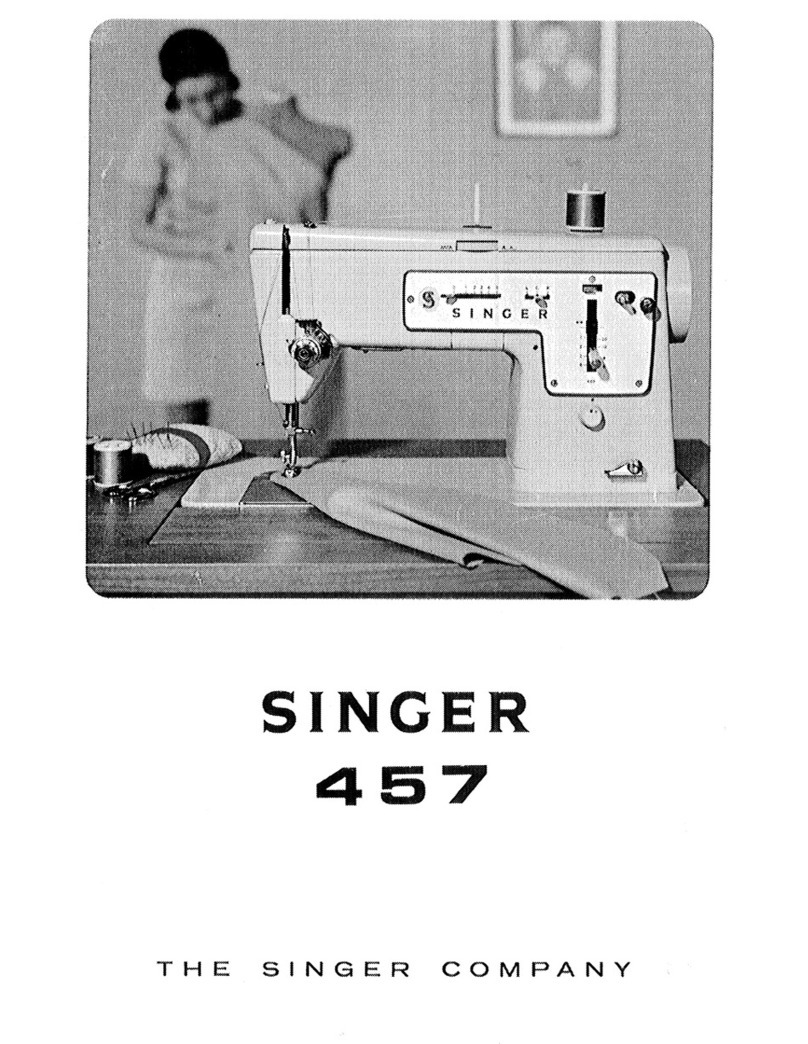
Singer
Singer Stylist 457 manual
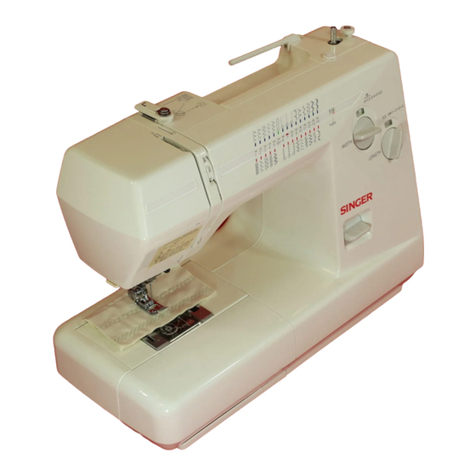
Kenmore
Kenmore 384.18024000 owner's manual
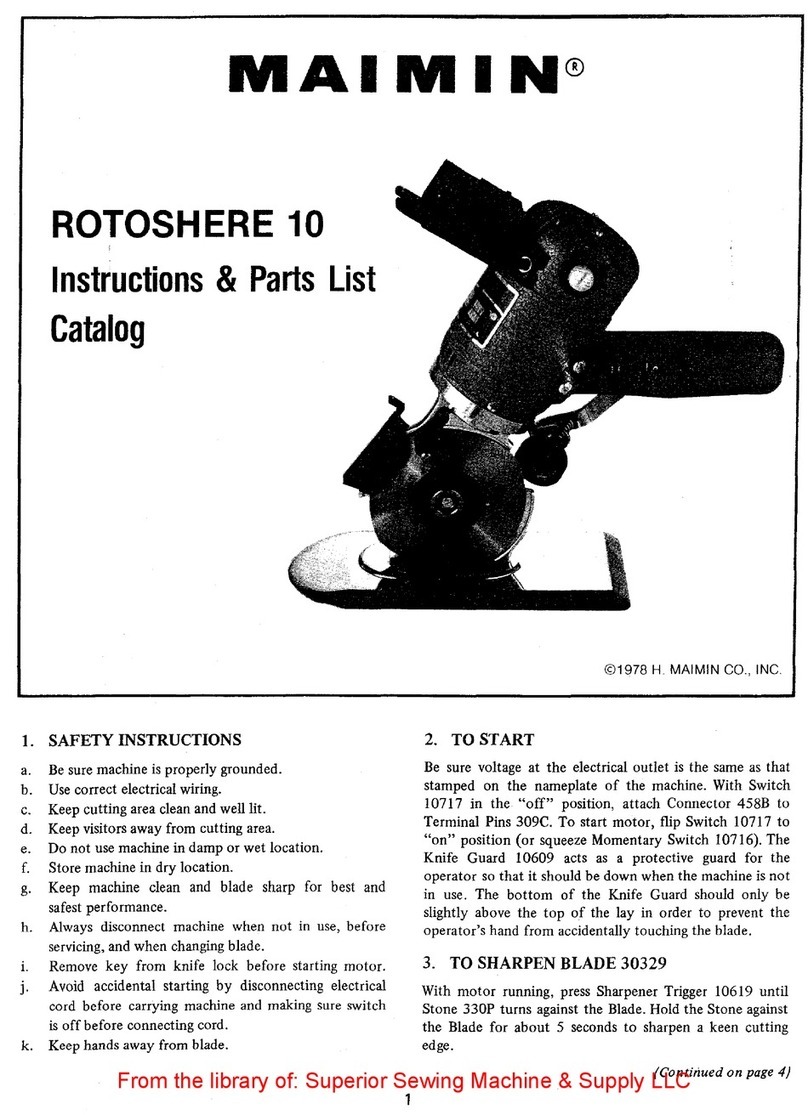
maimin
maimin ROTOSHERE10 Instructions & Parts List Catalog
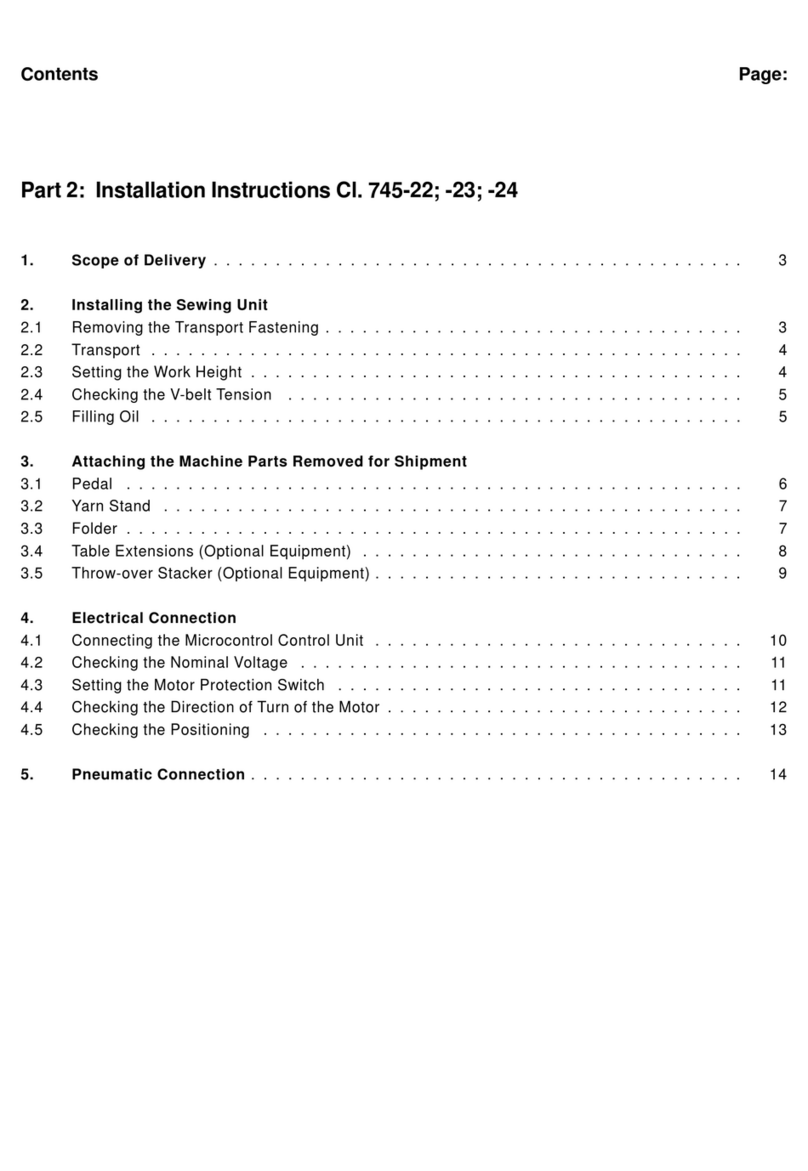
Duerkopp Adler
Duerkopp Adler 745-22 Installation instructions & replacement parts list

DURKOPP ADLER
DURKOPP ADLER 827-M operating manual
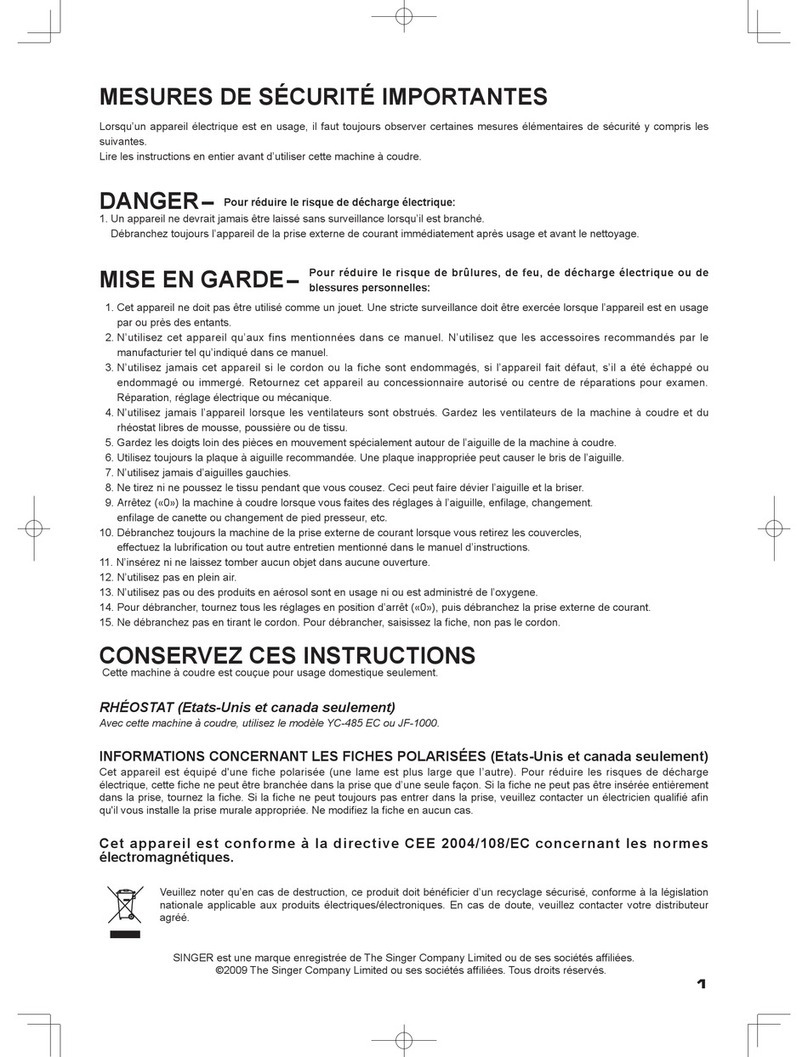
Singer
Singer Futura SES2000 instruction manual

